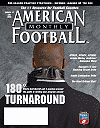AMERICAN FOOTBALL MONTHLY THE #1 RESOURCE FOR FOOTBALL COACHES
Article CategoriesAFM Magazine
|
Advanced Level Techniques for Today\'s Quarterbackby: Jeff hancockTight Ends Coach, Grand Valley State Uni © More from this issue I have had the fortune of coaching at many different levels through the years. One thing that I have found is that at the ‘Non D-I levels’ it is hard to find a quarterback with good mechanics. The higher levels take their pick from the kids that are gifted athletically as well as mechanically. This becomes especially tough when you run an offense that revolves around the pass. This article will focus on what I believe to be the proper mechanics of the QB throw. From the set-up/stance to the follow through, I have broken down the QB throw into 4 different phases. Obviously, there are phases leading up to the set-up/stance depending on the type of drop and whether your QB is going out of the ‘gun’ or under center. The four phases include: stance, cocking or loading phase, throw or ‘acceleration’ phase, ....The full article can only be seen by subscribers. Subscribe today!
|
|
|||||||
| HOME |
MAGAZINE |
SUBSCRIBE | ONLINE COLUMNISTS | COACHING VIDEOS |
Copyright 2025, AmericanFootballMonthly.com
All Rights Reserved





